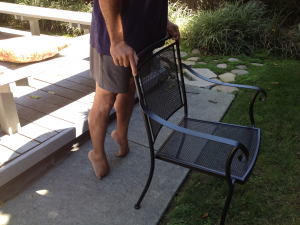Ever since I started running barefoot, I’ve always been looking for ways to strengthen my legs so I can run better, faster and be injury free. Not too long ago, I went to my older son’s friend’s dance performance. I saw some amazing kids there doing ballet and guess what they had on their feet? Nothing. Nada. Zilch. They were doing the pirouettes, releves and curtsies with no cushioning. Didn’t it hurt? How can they do this when just after a few miles of running, I’m coming back home all beat up? So I started digging around.
Use Ballet Exercises When you Start Running

Photo by dalbera
I found out the ballet dancers and runners have very similar injuries. When we start running, we may not be curtsying around or doing pirouettes when we run, but there are elements of ballet dancing that are very much applicable in running. Check out this report from the Physical Medicine and Rehabilitation Clinics of North America titled Foot and Ankle Injuries in Dance. And here’s another one titled Injury in ballet: a review of relevant topics for the physical therapist that has similar injury rates. Here are some relevant quotes from the reports:
Previous studies have reported injury incidence rates of 67% to 95% among professional ballet dancers…The foot and ankle of a dancer are particularly vulnerable to injury and represent 34% to 62%of all injuries reported.
The literature indicated that 65-80% of ballet injuries are in the lower extremity, 10-17% occur in the vertebral column, and most of the remaining percentage are upper limb injuries (5-15%).
Soooo, that was interesting. I wasn’t the only one busting my ankles and feet when I started to run. What do these ballet dancers do beyond just stretching on bars and rails? Turns out they’ve figured out all kinds of interesting exercises. I found three that worked for me, were super easy to do, but incredibly effective for strengthening the calves and feet.
Heel Raises
The positions of the feet in ballet is a fundamental part of classical ballet technique. I usually pick the first or second position (Remember I’m trying to run, not dance) and then lift the heel as far as I can and then bring it back down. I started with doing 3 sets with 10 repetitions in each set and slowly worked my way over many months to do 60 at a time. Oh, you’ll feel your calves melt like butter with this one. Rest up between sets. I do this many times a day, during computer breaks, sometimes in meetings, etc.
A simple variation of this is to use a table or a sturdy chair with most of your weight on your arms. Now lift up your heel in either the first or second position and hold it there for 10 seconds. Do three repetitions with tons of rest between them. I started with 10 seconds and then slowly worked up to longer durations over many months. The heel lifts stretch your Achilles tendon and strengthen your calf in a very effective way.
Toe Curls
I don’t even know if this is an official term! 🙂 This one is a little trickier to do than the heel lifts, but I can really feel my ankles and feet getting stretched. Stand flat on your feet with arms resting on a sturdy table (or kitchen counter). Shift your weight so most of it is on your arms. Now curl the toes of one foot and then the other. Over time as you get stronger, you can slowly shift more weight to your legs. Hold this for 5 or 10 seconds, until you feel the stretch. Lean forward to move the weight back to your arms and uncurl your toes to make them flat. I personally love this one and it feels so good to stretch out your ankles and feet after a 10-mile run.
Résistance de T-shirt
You could do this with a Thera-Band, though an old cotton t-shirt works much better. Sit on a yoga mat with your legs straight in front of you and toes pointing up. Cover one foot with the old t-shirt and pull it towards you so there’s resistance. With your toes still curled up, push forward with your ankle and when it’s as far as you can take it, try and point your toes away from you. You should feel the resistance on your ankles and toes. Bring it back slowly and do 3 sets of say, 5 repetitions each. Especially when you are starting to run, this is such a great way to strengthen all those little bones, muscles, tendons and ligaments on your atrophied feet.
[sc:follow_me]


